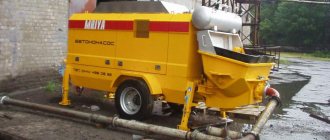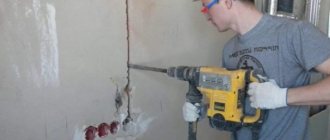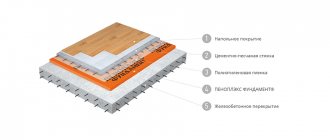A concrete pump is a construction device designed to supply a mixture of solution to a construction site. He takes the latter into his bunker from the corresponding reservoirs. These are concrete mixers or tanks for storing liquid concrete. Using a special outlet, the unit can deliver the solution to a fairly large height or over a long distance if delivery is carried out in a horizontal direction. It is also used where large areas need to be poured with concrete. For example, to pour the formwork of a future building, it would be necessary to carry the solution in buckets for a long time if there were no stationary concrete pump. A photo of this device can be seen below.
There are not only stationary concrete pumps
In this article we are talking specifically about stationary type mechanisms. But a few words are worth saying that they are not the only devices designed for pumping concrete.
Automobile concrete pumps (ACP) are devices transported on the chassis of most truck manufacturers. It is advisable to use such transportable massive devices in cases where it is important to quickly deliver large quantities of solution and quickly transport the equipment to another location. Most often, mobile concrete pumps are used to create the foundations of buildings. In addition, such devices can be much larger than stationary ones, and therefore more powerful.
This concludes the description of mobile concrete pumps within the framework of this article; let’s move on to other devices.
The vital necessity of concrete mixer trucks
Today it is difficult to imagine even a small action in construction without concrete. Truck-mounted concrete mixers, called differently (mixer, truck-mounted concrete mixer, or abbreviated as ABS), have become mandatory construction paraphernalia. They are used to produce a mixture of cement, sand, solid additives and water.
The positive aspects that formed the basis for such a wide distribution of such combinations include:
- The “three in one” principle allows you to reduce organizational costs at construction sites. There is no need to rent a concrete mixer, concrete pump, or lifting equipment;
- The driver of the car, who is also the operator, manages the entire process of obtaining concrete mixture and delivering it to the site;
- One truck-mounted concrete pump with a concrete mixer provides cost-effective operation on small sites due to the accelerated turnaround time for concrete work. Practice shows that concrete work is completed at least 2 times faster when using a concrete mixer;
- The machine makes it possible to transport concrete to the site 4-5 times, which allows you to work with freshly prepared mortar;
- A concrete mixer truck occupies a small space on a construction site (on average its dimensions are 5 x 10 m);
- The ability to easily maneuver the machine, and the mobility of organizational work;
- Climatic conditions do not affect the quality of the finished solution during transportation to its destination.
Attention: Ideal machines simply do not exist in nature. A major drawback of the design can be considered the discrepancy between its mass and the volume of the drum (tank).
In addition, truck-mounted concrete pumps with a concrete mixer must be equipped with high-power electric drives, which also refers to the shortcomings of these mechanisms.
Purpose of concrete mixer trucks
The name of this miracle of technology contains the answer to the purpose of this design. And yet, you can’t just shrug it off and pass by this brilliant combination.
Outdated models with a capacity of up to 5 m³ are gradually losing their positions, because... The requirements for modern designs are constantly growing.
It has been correctly noted that in our country there is nothing more durable than temporary buildings, so mixers with a small tank volume will continue to exhaust their resources for a long time. Moreover, the safety margin of components and mechanisms of domestic mechanical engineering products has always been sufficient for long-term operation without repairs.
The main task of the automixer is:
- Loading dry components into a tank using a special installation to prepare a concrete mixture during the journey to the place of arrival;
- For mixing the mortar directly on the construction site;
- A concrete pump with a concrete mixer brings maximum benefit on large objects and construction sites located at fairly distant distances;
- The concrete mixer truck is designed to fulfill the strict requirements imposed by GOST for the transportation of concrete, namely:
- When transporting concrete, it should not be exposed to precipitation or direct sunlight;
- The instructions also instruct to prevent loss of concrete mixture during delivery and unloading.
The video in this article clearly demonstrates how ready-mixed concrete is supplied and distributed on a construction site.
Who matched the car to the concrete mixer?
The mid-30s became the date for the release of unified vehicles in the USA. They were called delivery concrete mixers, and were intended not only for transporting concrete solution from the plant, but also for producing it on the way.
Modern domestically produced designs have a foreign accent because Soviet designers used foreign experience. Just like in foreign cars, there are Russian notes, because our specialists are also “not born.”
Stationary
As mentioned above, in addition to a mobile one, there is a stationary concrete pump. Devices of this type are not designed for independent movement on urban roads.
In order for such a pump to be conveniently moved within the construction site, it is usually equipped with a chassis. If necessary, the stationary mechanism is transported on a trawl or using a truck.
Such devices are very often used during the construction of skyscrapers and simply tall buildings. An example is the world record for delivering concrete to heights using a pump, which was set by Putzmeister stationary concrete pumps. The height record was as much as 606 meters, which indicates functionality. Pumps of this type can also deliver concrete over long distances in a horizontal plane.
At the construction site, a location is chosen that always has access for automixers. This is necessary for timely unloading, because pauses in the operation of the device do not benefit it. A concrete delivery system is attached to the unit. In essence, it is flexible wide pipes connected to each other.
The operation of the mechanism will no longer be flawless if it is not lubricated with starting mixture. This is where the work begins, and this is done all the time, without interruption. After all, if the solution thickens, a plug will form in the concrete pipe.
If the action requires long pauses, the mixture must be passed through it at least once every 15 minutes.
Linear Grand-Aquarius Mobi
functions of a stationary and truck-mounted concrete pump - linear concrete pump
We offer Grand Aquarius pumps for concrete supply. From us you can buy stationary concrete pumps and truck-mounted concrete pumps under financial lease schemes from partner leasing companies.
The transfer of ownership of SO Grand construction equipment includes free consultations, warranty and post-warranty support for the equipment, and training for the concrete pump operator when putting the machines into operation.
Sales of concrete pumps from the manufacturer in Russia
You receive modern construction equipment adapted to domestic building materials, fuel and electrical networks, worker qualifications, the general level of service, the spare parts and components market.
Features of concrete pumps jointly produced in Russia and India: serious mechanical protection, ease of maintenance, unpretentiousness and declared performance. The range of concrete feeding equipment includes: trailed concrete pumps, stationary concrete pumps with diesel or electric drive. As well as truck-mounted concrete pumps, linear concrete pumps with an autonomous concrete supply unit.
Save money. Choose quality for reasonable money. Order concrete pumps from SO "Grand"
The partner of JV GRAND, the Indian engineering company Aquarius, is part of the largest concern Tata. Aquarius specializes in concrete pumping technology, developed by the world's most respected concrete pump company. Aquarius factories have preserved the engineering and technical traditions of their German founders in the production of construction equipment in India.
Pumping group of stationary concrete pump Aquarius-Grand
The pump group was developed with the participation of leading engineers of Aquarius Engineers Pvt. Ltd. As a result, Grand Aquarius concrete pumps are equipped with a simple, reliable, understandable design that is easy to maintain in the shortest possible time.
The concrete pumping group is equipped with:
- Hydraulic cylinders;
- S-valve;
- Receiving hopper;
- Cooling chamber;
- Protective grille.
- Abrasion plate, shear ring;
- Rubber quick-change pistons;
- Chrome plated concrete feeding cylinders;
- Shaft in the mixing hopper with hydraulic motors;
- Transition pipe from 150 mm to 125 mm with a ball catcher;
The cooperation of SO Grand and Aquarius has made it possible to develop and offer to the world market concrete pumps that perfectly perform their tasks all year round on construction sites in Africa, Indonesia, Asia and Europe in difficult conditions and different temperature conditions.
The company offers for sale and rental:
- stationary and mobile concrete pumps;
- distribution booms;
- concrete pipes.
Structure
In order to carry out timely and correct maintenance of the unit, you need to know how a stationary concrete pump works. The technical characteristics of different devices may differ, but their structure is approximately the same:
- Grate vibrator that protects the hopper.
- Hopper protection grid.
- Lubrication system.
- Shiber.
- Hopper with mixing device.
- Gate cylinders.
- Feed cylinders.
- Cooling tanks.
- Drive cylinders.
Existing types of stationary devices
It doesn’t matter whether you choose a mobile concrete pump or a stationary concrete pump, the characteristics depend not on the method of movement of the mechanism, but on the type of its device.
Devices of the second type may have fundamental differences in their design. To know which pump to choose for a particular purpose, you need to know this difference.
The unit may be a piston unit. In such a system, concrete is directed through pipes using two pistons. There are also single-piston devices.
In curtain-type pumps, the concrete supply system is hidden by so-called curtains, which are located immediately in front of the concrete pipeline. In gate devices, instead of curtains, a gate unit is installed.
Classification of modern units
Modern concrete pumps are classified according to various features and characteristics.
So, for example, concrete pumps can be classified according to engine power parameters and the overall dimensions of the concrete dispensing boom. The maximum length of this element can reach no more than 70 m.
In addition to this unit, the following types of mini pumps with accessories can be purchased at a hardware store:
- Diesel;
- Manual;
- Rotary;
- Small-sized;
- Screw;
- Portable;
- Gerotor.
Classification by type of autonomy
In accordance with this feature, concrete pumps are divided into 2 types:
- Stationary. The main advantage of units of this type is an increased level of power compared to devices from another group, the highest level of reliability and the ability to operate in difficult conditions. But in addition to these advantages, stationary concrete mixers also have disadvantages. It should be noted that such units are not able to independently move to the construction site. To transport such a unit you will need a specialized trailer. The concrete mixture is supplied through a hose, since the design does not provide for the use of a boom;
- Mobile. Renting devices of this type is in great demand among developers. They are often called a concrete pump or ABN. Mobile, fairly compact equipment is a specialized vehicle actively used for pumping liquid concrete into any form. Most specialists consider this type of concrete mixer with a pump to be the ideal equipment for working with concrete.
The photo shows the ABN diagram
Classification by feed type
According to the method of supplying concrete solution, units of this type are divided into:
- Piston . They provide for the supply of concrete due to the operation of the piston. Such installations are divided into:
- Curtain ones, in which the concrete conveyor and the feeding mechanism are separated using curtains;
- Slide valves, in which separation occurs thanks to a slide valve, which comes in the shape of the letters S and C;
- Vacuum . Provide for the creation of a vacuum in the solution receiving tray. With its help, mass moves.
Devices with gate
The concrete pump (stationary or mobile, it doesn’t matter) can be a vane pump. The gate (damper) is the main mechanical part of the device. It can be made in the form of a rotary pipe, trunk, wedge.
The gate is always made strong and thick. Its surface should be smooth. Otherwise, the unevenness will be reflected in the concrete, because with high pressure, such as occurs in the mechanism, each unevenness leads to the solution protruding to the surface.
The gate must also be wear-resistant, otherwise it will quickly fail in such aggressive operating conditions. It is not found in rotary type concrete pumps.
Potential difficulties when laying the mixture with a concrete pump
In standard mode there are no problems. They appear when the operating rules of the installation are violated.
- The mixture should be fed evenly and at medium speed to avoid the appearance of cavities in the monolith.
- The reinforcement frame must be firmly fixed so that the flow of the mixture does not tear it off.
- When the work is completed, all parts of the concrete pump must be washed to prevent the concrete from hardening.
- Personnel must hold the end of the concrete pipe, especially during heavy flows.
- Work should be organized so that there are no interruptions. Interruptions can lead to hardening of concrete and the formation of traffic jams.
- If a plug has already begun to form, the pipe is disconnected and the problem area is cleaned manually.
If you do not violate the rules of use, then laying concrete will go smoothly and without difficulties.
Rotary
The rotary element is capable of pushing through a mixture whose density could not be handled by another type of device. The concrete moves through the pipes, guided by rollers in the rotor. The rollers exert pressure on the pump with sleeves that compress and unclench. This difference is what makes the rotary apparatus so effective.
The stationary rotary type gasoline pump is also distinguished by its relatively quiet engine operation.
If the mixture hardens inside the outlet, it is enough to turn the engine rotation mode in the opposite direction.
Piston
Nowadays, two-piston units are used; single-piston systems are gradually becoming a thing of the past. These pumps are equipped with a diesel or electric motor.
A stationary diesel concrete pump is capable of providing high speed concrete delivery. Per second, such a pump can transfer up to 60 liters of mixture to its destination.
In an hour of operation, a standard diesel concrete pump pumps about 60 cubic meters of solution. In the horizontal plane, the mixture can be transmitted over a distance of up to 300 meters. The height feasible for an average diesel stationary pump is 70 m.
The two pistons are connected by a hydraulic drive cylinder.
The system can be not only hydraulic, but also electro-hydraulic, single-circuit and double-circuit. Each variety has advantages and disadvantages.
Application of concrete pumps
Concrete pumps are designed to transport concrete mixture to the placement site. They are indispensable when it is necessary to pump a large amount of concrete mixture in a relatively short period of time without loss of quality and increase in operating costs. The mixture can be supplied in both horizontal and vertical directions.
For example, the German company Putzmeister produces two types of concrete pumps: truck-mounted concrete pumps (mounted on a vehicle chassis) and stationary concrete pumps.
Putzmeister truck-mounted concrete pumps are used in the construction of residential and commercial buildings, tunnels, bridges, roads, multi-storey structures (for example, when laying foundations, underground parking lots and the construction of first floors), full-fledged construction of low-rise buildings and other structures.
Stationary concrete pumps are involved in the construction of high-rise buildings, tunnels and other structures in conditions where the use of automobile concrete pumps is impossible due to the technical parameters of the project or operating conditions. For example, the mixture must be applied to a ceiling at a height of over 70 meters and over an area of more than 30 m². In most cases, a concrete pump is used in conjunction with concrete pipeline and distribution boom systems.
How to choose the right one?
How to choose a suitable concrete pump? A stationary unit can be equipped with two types of piston system: mechanical or hydraulic. The choice depends on the goals of the buyer of the device.
The construction of each facility requires individual selection of construction equipment. The performance of stationary devices is determined by the operating principle of the device and its brand. On average, it can vary from 15 to 85 cubic meters of delivered mortar per hour. The maximum height to which stationary concrete pumps are capable of delivering the mixture is 150 meters. Horizontally, concrete directed by a pump can travel up to 450 meters. In addition to the characteristics of the device itself, you need to take a responsible approach to the choice of outlet pipes, because the functionality of the entire solution supply system also depends on them.
So, we found out what a stationary concrete pump is. We hope the information presented will be useful to you.









